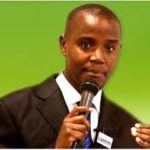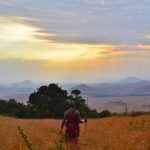Despite the political chaos and violence of early 2008, Kenya’s LGBT community continues to grow and organize around rights, health and compassion.
The day I arrived in Nairobi the results of the presidential 2007 election had just been announced, which many believed to be fraudulent. The razor thin margin of victory was prematurely announced in favor of the incumbent Mwai Kabaki (a member of the Kikuyu tribe) before the final tallies were made.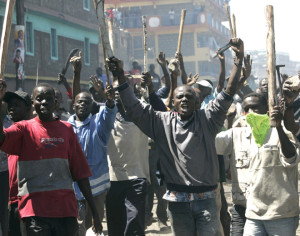
This obvious manipulation caused an explosion of frustration, anger and disbelief among opposition
followers of Raila Odingo (of the Luo tribe), some of whom went on wild rampages in small towns and villages throughout Kenya (including the slums around Nairobi) against members of the President’s tribe. (Not surprisingly, other allied tribes, such as Kalenjin, as well as generic streets gangs also took advantage of the chaos to loot and attack.)
Over the course of the next 60 days, 1500 people died and hundreds of thousands were displaced to instant refugee camps inside Kenya and adjacent Uganda. Homes, businesses and churches were torched–some with people trapped inside—shops looted, many others assaulted with machetes and clubs. (see photo gallery)
Rape and sodomy against women and children were reported while the political leaders (photo left) dithered, argued, shouted and finger-pointed at each other. The tribal-political warfare was hysterical, merciless and bloody.
It was a shocking start to my first visit to Kenya. Needless to say, there was not a lot of LGBT activity happening in the city at that time–not that an observer would see much in peaceful times.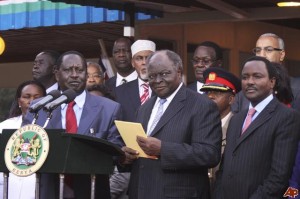
Much of the gay energy in this city of 3 million happens quietly behind the masks of social and health-related activity. The ‘gay movement’ here is being done the African way: slow, persistent, indirect and daring.
Lunch with Angus
One of the best ways to grasp the diverse LGBT scene here was to have lunch with Angus Parkinson at Trattoria restaurant in central Nairobi. A good-looking angular white man of 27 from UK, he has lived in Kenya for five years working in HIV health care programs. Currently he is the MSM Services Coordinator at Liverpool VCT, based in the suburbs of Nairobi. VCT (http://liverpoolvct.org/msm.htm) originated in the UK and is one of the major providers of HIV testing and counseling in Kenya. It is to his credit that MSM (men who have sex with men—gay, straight and in between) have been included in Kenya’s national HIV prevention strategy plan.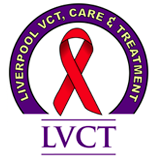
His years in Africa have imbued a certain cynicism in his view of health care work here. He has seen a wide range of ‘care’, from self-serving misuse of funds to openhearted goodness. Not unlike high-ranking government officials who usually skim a percent of foreign aid, the health industry bureaucracy also takes its cut.
The labyrinthine world of health care activity here and throughout Africa is beyond comprehension; it’s a huge industry, a many-headed hydra with tentacles grasping for the mounds of money available from hundreds of government and non-government donors.
Angus has survived intact because of his ability to float, dodge, improvise and persuade. He is quick to add the force of context here: this is poverty-stricken Africa where ‘grasping’ is inseparable from survival. Achingly high unemployment and the self-serving manipulation of wealth by the privileged political few leave many people scrambling for work and opportunities for income.
“There are a lot of good people working in healthcare yet too many are under-qualified or have accessed money through dubious job descriptions. Any big charity operating in Africa has to expect that. You get used to it—and forgive it, sort of,” explained Angus.
Angus’ overview was comprehensive as he parsed out the politics and programs and personalities of the HIV industry–interwoven with the issues, opinions, actions and attitudes of the many LGBT personnel who work quietly within these systems.
His recent life has been in crossover roles of health educator, gay activist, mother-protector for rejected gays, information source/lobbyist for LGBT issues to the Kenyan ministry of health and, not least, an openly gay outspoken man working in a homophobic environment. He can afford that privilege since he has no tribal family pulling him into long held traditions of marriage and procreation wrapped in Christian missionary zeal. Most Kenyan homosexual citizens are not so lucky.
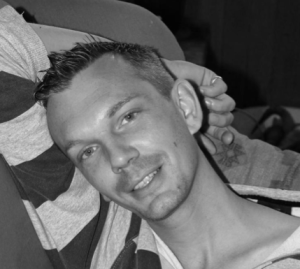 Angus (photo left) described the gay movement here as still nascent, still sorting out, still defining goals, strategies and organizational schemes. At most the movement goes back fewer than ten years of lean-funded covert work.
Angus (photo left) described the gay movement here as still nascent, still sorting out, still defining goals, strategies and organizational schemes. At most the movement goes back fewer than ten years of lean-funded covert work.
The movement, if it can be called that, is weighed down by the darkness of cultural, religious, political and legal homophobia that runs through the social blood of the various tribal, religious and political cultures in Kenya. Homosexuality is a criminal offense here; women are not mentioned in the laws.
There is no gay center in Nairobi , no particular place for estranged gay youth or alienated adults to find hands-on advice, food or shelter (other than in private HIV offices). There is no LGBT publication, no outward signs or campaigns, no rallies, no fair media representation.
But things are changing.
Stillness in the CBD 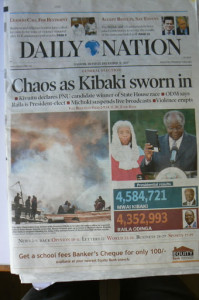
The day after my lunch with Angus, an eerie stillness crept over the city as a public ‘prayer’ demonstration called by the opposition party ODM (Odinga) was imminent but forbidden by the ruling PDN government (Kabaki). It threatened to bring more violence, this time very close to the central city. Workers stayed home and normally hectic Nairobi central business district (CBD) was like a ghost town.
Hundreds upon hundreds of riot-gear police, looking like robo-cops in their helmets, visors, shields and guns, were stationed around the government buildings as I decided to take a walkabout.
With camera discretely grasped within one hand I moved around the area snapping images of the catholic cathedral, street sweepers, deserted streets, parliament (until a guard grabbed my arm declaring parliament photos were forbidden that day), and the tall tower of the huge Kenyatta conference center.
After seeing the high court I circled back to the cathedral grounds where I saw some shrubbery that would screen me while I took some photos of the police without being banged on the head with a baton.
As I sat in the cathedral waiting for my clandestine photo-op I heard gunshots outside that echoed through the huge nave. I went outside and saw smoke blowing away from the location of the shots. I headed toward it 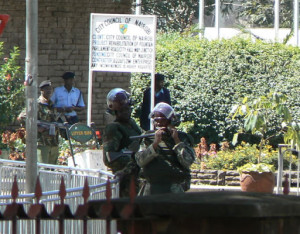 but was stopped in my tracks by tear gas that immediately seared my lungs and eyes. I backed into the cathedral to take some deep breaths and wipe my flowing tears. It is nasty stuff.
but was stopped in my tracks by tear gas that immediately seared my lungs and eyes. I backed into the cathedral to take some deep breaths and wipe my flowing tears. It is nasty stuff.
That evening, on TV, there were videos of rock-throwing gangs confronting the police who used tear gas and water cannons to prevent them from gathering in the park.
These murderous and dangerous mobs of young men were lethal. Encouraged by opposition politicians (Luo tribe) they had attacked government allied (Kikuyu tribe) individuals, shops, homes, churches and markets—mostly in the poor areas—looting, killing and raping as they went.
One news report told of 50 people—women and children– being burned alive in a church or hacked to death as they tried to escape. Another reported some 35 rapes including sodomized young boys by the roving killer gangs.
GALCK—Gay and Lesbian Coalition of Kenya
Despite the temporary political crisis, which has continued for over three months into 2008 as the two opposing parties fight over cabinet ministers, gay energy remains alive in this otherwise prosperous country in the form of the Gay and Lesbian Coalition of Kenya (GALCK), an umbrella organization composed of several member groups.
I n June 2006 these separate groups came together with financial help from donors such as Urgent Action Fund, Hivos, and Ford Foundation to form GALCK as a unified voice on behalf of human rights, and health care,
n June 2006 these separate groups came together with financial help from donors such as Urgent Action Fund, Hivos, and Ford Foundation to form GALCK as a unified voice on behalf of human rights, and health care,
GALCK is headed by a steering committee and coordinated by Pouline Kimani (photo left), a spirited and handsome Kenyan lesbian activist in her twenties. I caught up with her in Uganda where she was meeting with activists and friends. Pouline is pleased with the recent progress of GALCK in building community solidarity. She said prior to 2006 people were scattered into various HIV-LGBT groups doing their own things and not coordinated.
Currently GALCK consists of four groups: Gay.Kenya.com, MWA (Minority Women in Act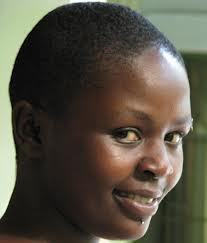 ion), TOMIK (The Other Men in Kenya) and Ishtar MSM. Closely aligned are Liverpool VCT and KAVI (Kenya AIDS Vaccine Initiative) doing separate HIV and consulting work.
ion), TOMIK (The Other Men in Kenya) and Ishtar MSM. Closely aligned are Liverpool VCT and KAVI (Kenya AIDS Vaccine Initiative) doing separate HIV and consulting work.
At first there were some rough patches as unequal small and large groups adjusted to a coalition where all had an equal voice. As well, class issues arose as middle class people were not at first comfortable dealing face-to-face with lower status sex workers (involved through Ishtar and VCT).
Pauline has been a uniting force bringing increased harmony and effectiveness to GALCK. Trans issues, awkward for some queers, were addressed early on since Pouline is partnered with Victor Mukasa, a well-known and respected F2M activist and leader in Uganda.
An important motivation to form GALCK was the 2006 conference ‘Changing Spaces-Changing Faces’ in Nairobi that included diverse LGBT organizations from all over East Africa. The meeting was co-hosted by the non-government (NGO) Kenya Human Rights Commission, headed by Muthoni Wanyeki. The conference was an effective vehicle for gay groups to form closer ties with one another as well as to make high-level contact with the governmental Kenyan National Human Rights Commission. Subsequently Pouline was invited to join the advisory committee of the Kenya Human Rights Commission regarding issues of discrimination.
“GALCK’s first public appearance was at the World AIDS Day on 1st December, 2006. GALCK had a stand at which its members gave information on safer sex for LGBTI individuals. The members also answered questions from the public on LGBTI issues. The stand was very popular with people swarming to ask questions and express astonishment at the public declaration and identification of Kenyans as LGBTI individuals. They were even more surprised to learn that there are LGBTI organizations in Kenya. However, there was absolutely no media coverage on the matter,” wrote Pouline in a description of GALCK.
Another GALCK Success
GALCK’s second success in 2007 was its presence at the Nairobi World Social Forum (WSF), a meeting held every year as a shadow forum to the G8 Summit of wealthiest countries.
Thousands of attendees from many peace-green-justice organizations around the world were present each with a tent or stall displaying their mission and membership. Among them was the GALCK booth offering books—their own and from abroad—publicity posters, T-shirts, information brochures about homosexuality, gay rights, HIV/AIDS data and safe sex as well as referrals and invitations to talk about or join GALCK. (See Kenya News and Reports 2007)
Needless to say, the media zeroed in on this ‘sensational’ group of “homosexuals in Kenya”, which gave GALCK some helpful free publicity; they dubbed the booth the ‘Q-spot’.
Further, the nearest thing to a gay parade in Kenya also took place at the WSF when the many groups formed opening and closing processions in a stadium to strut their stuff and show their banners; GALCK was there with their rainbow colors in the very public Uruhu Park in central Nairobi. (photo left)
As activist Val Kalenda (of Uganda) wrote: “It was an emotional moment for us all when we held a pride march at the University stadium on the third day of the Forum. A group of feminists joined us. The stadium went on fire. It was such a spectacle. That homosexuals can have a pride march in a country where homosexuality is illegal is something I still marvel at.”
Perhaps inspired by GALCK’s courage, a recent 2007 documentary film, entitled ‘7 Years’, about gay Kenya was produced by a Dutch film-maker about the same time.
An extensive description of GALCK and its mission and projects written by Pouline can be seen on this link. An important next goal is to open a public community center where people can meet, learn and connect about social, health, legal and personal issues.
Personal Issues
Not uncommon in Africa, a hardscrabble continent of cheap manual labor, few skilled opportunities and widespread hardship, Pouline’s personal life is shadowed by difficult circumstances. She was a law student until recently when her mother pulled the plug on her school fees because of her public lesbian/feminist activism.
If she quit GALCK and ‘settled down’ her mom would restart the funds. “She’s well educated and liberal and even supports LGBT rights in general, but not having an activist daughter. She’s been spoiled by religion—everyone is blinded by one sort of Christianity or another here,” she explained. In her family, only her 18 year-old brother remains supportive of her; a sister is not. Homosexuality is a very divisive issue among immediate family members here, ranging from warm acceptance to silence to violent rejection.
Encumbered but not stopped, she carries the torch openly for GALCK and continues outreach and education activity to the public and to human rights professionals in Kenya, some of whom, surprisingly, are still reluctant to extend equal rights to LGBT Kenyans.
GayKenya.com
There is a sizeable LGBT community here in Nairobi, a city of almost 3 million, and as usual most are not (or cannot afford to be) interested in advocacy and activism. What does it take to be in that small minority of volunteers who attend to a higher cause than everyday food, work and shelter: a consciousness higher than one’s own ego or stomach.
Such a one is Dennis (not his real name) a member of one of GALCK’s major groups, GayKenya.com. He is an Internet consultant by day and an activist by stealth after work.
Dennis’s group made history in 2005 by publishing the first serious book about Kenyan homosexuality ever to appear in the country. Entitled ‘Understanding Homosexual People in Kenya—The Cultural, Health, Religious and Legal Issues’ mostly written by Dennis.
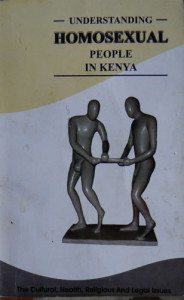 The book includes an overall analysis of homosexuality in Kenya (by Dennis) along with recent newspaper and magazine reports about LGBT issues as well as commentaries by half a dozen contributors. It also includes a selected bibliography of which, not surprisingly, none originated in Kenya. Although hardly a best seller at one thousand copies, it did sell out. A second edition is planned for 2008.
The book includes an overall analysis of homosexuality in Kenya (by Dennis) along with recent newspaper and magazine reports about LGBT issues as well as commentaries by half a dozen contributors. It also includes a selected bibliography of which, not surprisingly, none originated in Kenya. Although hardly a best seller at one thousand copies, it did sell out. A second edition is planned for 2008.
Expressing high hopes for change, Dennis wrote: ”Some people believe that Africa will only survive in the new world order if it makes a break with the past and adopts new paradigms of thought and action.” A very high hope indeed since a fundamental fact of gay life in Kenya is the ingrained fundamentalistic Christian attitude that informs and defines much of ‘moral’ life in Kenya. Faith is everywhere: scriptural phrases and Biblical scenes are painted on buses; businesses are labeled ‘Redemption Dry Cleaners’ and ‘Gospel Bakery’. One man I met was actually named Godbless!
(A previous book publication was the 2004 book ‘Same Gender Unions: A critical Analysis’, a biased compilation of homophobic opinions from ‘experts’ not in the field of law or psychology.)
Legalizing Homosexuality
GayKenya.com–which does not sport a name banner on its web site to protect members and inquirers from being exposed at Internet shops in Kenya where prying eyes can wander from adjacent computers–is primarily an advocacy group to government ministries and bureaucracies that deal with legislation, health care and human rights.
They lobby for decriminalization of homosexuality in Kenya. Their studied approach involves gathering respected pronouncements from reputable organizations (dealing with sexuality and health) and authoritative individuals (medical and legal experts) attesting to the normalcy of sexual differences and to the constitutional rights of all Kenyans. They also include academic research data and human rights reports from national and international organizations
The arguments they present, first, urge government health officials to consider that criminalized homosexuality significantly inhibits sexually active high-risk MSM’s from seeking HIV care and counseling about safe sex, which in turn perpetuates the disease.
Second, to understand that the same punitive law promotes homophobia in the workplace and leads to otherwise qualified personnel being removed or prevented from skilled work thus diminishing the quality of Kenya’s work force.
Dennis knows it’s a slow process of advocacy but an effective one if developed carefully over time.
GayKenya.com also offers on their web site a live chat room, forums for discussions, information and referrals for health care and relevant news reports. There are about 30 members of the group headed by a steering committee.
Friends Everywhere
However, Dennis further noted, the heart and pulse of gay Kenya are the friendship networks that thrive invisibly here offering personal and social interaction and assurance. Parties—theme parties, dinner parties, birthday parties, holiday parties, no-reason parties happen regularly at private residences or occasionally at a rented public venue.
There are also several gay-friendly bars and clubs in Nairobi such as Simmers, Tropez, Tacos and Gipsy and Florida disco (x2) that draw mixed crowds nightly (More about Gipsy below.)
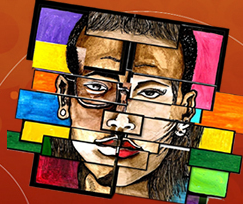 Still there is caution. As Dennis and I spoke, a Kenyan gay male duo (lovers? friends?) came into Tropez for a drink, sitting on the balcony not far from us. Nothing more than slight glances were exchanged with us. A casual observer would hardly guess they were gay but for keen gaydar. Even then unless approached by a known friend, one would not comfortably risk an overt ‘gay gesture’ in public. Even in mixed venues such as this one, polite indifference toward strangers is the customary mask of discretion.
Still there is caution. As Dennis and I spoke, a Kenyan gay male duo (lovers? friends?) came into Tropez for a drink, sitting on the balcony not far from us. Nothing more than slight glances were exchanged with us. A casual observer would hardly guess they were gay but for keen gaydar. Even then unless approached by a known friend, one would not comfortably risk an overt ‘gay gesture’ in public. Even in mixed venues such as this one, polite indifference toward strangers is the customary mask of discretion.
Lunch with Peter, director of Ishtar
Another group under the umbrella of GALCK is Ishtar, a name derived from an Egyptian deity of fertility who manifested both male and female aspects in one figure. The organization is a HIV/AIDS health education outreach program focused on MSM and transgender women, some of whom are professional sex workers.
We met on the balcony of Steak and Ale restaurant, overlooking a trendy downtown Nairobi intersection on a warm sunny afternoon, where he informed me about their work. Peter is a handsome articulate man of 30 who leads his 200 members in planning programs and organizing their rounds of the bars and clubs to offer condoms, lubricants and safe-sex pamphlets to customers and sex workers.
The need for such proactive work was urged as a result of a recent poll of 500 gays which revealed an alarming 47% HIV infection rate, especially within the under-25 age group. As a result of the poll Peter, aligned with Angus, was instrumental in getting the National AIDS council to add MSM—especially young MSM–as a vulnerable group in their strategic planning. Additionally Ishtar presents safe-sex seminars which draw about 30 attendees each.
Because of the nature of the work, Ishtar is linked with other health-focused organizations such as Nairobi University medical department and the Kenya AIDS vaccine initiative (KAVI) and the Liverpool VCT.
As a result of the media attention at the World Social Forum, Peter was invited to be interviewed on a Nairobi radio station which had the desired effect of raising public consciousness about homosexuality in Kenya but also the undesired effect of rousing the Muslim imams to vigorously opposed this “abomination”. But Peter’s message was clear: if you are gay, come out, learn about yourself and learn to take care of yourself and don’t die young.
Peter’s radio message was also a personal statement: “I am a proud gay man; I love myself as I am; I have guts to say so and I’m not afraid to come out, not afraid to shock people into awareness that we are here as gay Kenyans—and that I have a boyfriend.”
Tea with the Lesbians
The ‘barrio’ is surrounded by gated and guarded middle class housing developments and estates of individual homes, condo complexes and eight-story apartment blocks with leafy gardens.
Here live several of the key players in Kenya’s emerging lesbian activist scene. I met four of them in the back garden of Maria’s fashionably furnished two-bedroom house where she served coffee, tea and biscuits.
I was guided there by Akinyi, the treasurer of their organization called Minority Women in Action (MWA) another one the four organizations under the GALCK banner. Also present were Laura a journalist and Helinah. Maria is an articulate and outspoken women’s rights consultant. Akinyi, whose mother is Swedish, works for the Kenyan Ministry of Science and Technology. 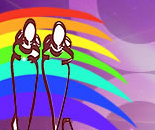
MWA is a recent group with 22 members and another twenty or so who attend meetings. (Women cannot afford the $7 annual fee are accepted as well.) The group was formed to focus activist work specifically on women’s issues.
Affiliated and friendly with the male dominated organizations in GALCK, the women felt they needed their own group. “We like and respect the men but I think they don’t understand how women are, how we feel, how we live, how we have our intimacies, our sexuality our emotions,” said Maria.
Initially MWA started informally as a social club for watching films and playing games until they got seriously talking about women’s issues and decided to develop some goals and strategies for making a difference for lesbians in Kenya.
Their vision for a better tomorrow is “an empowered organization that is nationally and internationally recognized which voices, advances, protect and advocates for the equality of LBTI women in Kenya.”
Akinyi pointed out that the law in Kenya regarding women’s sexuality is ambiguous. “Actually lesbians are not mentioned at all. What is illegal here is sodomy, as specifically stated. Lawmakers must have thought that only homosexual men engage in that!.”
Furthering their focus, MWA membership also includes a transitioning M2F person who has brought trans issues to the group’s attention, such as legal rights of identity and police brutality toward trans people in custody.
MWA also interfaces with the national Kenya Human Rights Commission and the ‘right’ people inside the government some few of whom who have lent a sympathetic ear to lesbian issues.
More problematic are the professional opinions of the Kenyan psychiatric/psychological associations who still harbor outdated attitudes about homosexuality. It’s an ‘old boys’ club resistant to seeing same-sex attraction as a viable sexual alternative. A leading psychiatrist, Dr. Frank Njenga, holds the religious/tribal view that homosexuality can be changed by treatment.
However, more modern voices are being heard and read, such as Dr. Christopher Hart who writes a ‘Men &Women’ column for the newspaper ‘The Nation’. He offers a neutral attitude toward homosexuality.
When asked if there was a precipitating event(s) that empowered the gay pride movement in Kenya, the women collectively responded with several answers: the opening of gay-friendly Gipsy bar/restaurant; the GALCK presence at the 2007 World Social Forum; the inspiring leadership of Anika Rodriguez’ from Norway helped create MWA in its inception; the leadership of Angus Parkinson from Liverpool VCT who helped develop leadership models; Auntie Ivy’s leadership and charisma that helped get ISHTAR up and running; MCC founder Troy Perry’s visit to Kenya in 2007 and his radio broadcast interview; and Anglican pastor, Father Mike, who has opened his church doors to the diversity of human sexuality.
As well, in the past 3 or 4 years half a dozen bars, discos, clubs (mentioned above) have opened their doors to the LGBT community which has helped LGBT folks feel more accepted.
Recent Update From MWA (2010)
Akinya sent these comments to GlobalGayz.com in 2010.
MWA has hosted the ILGA Women’s Secretariat status for about a year now. We have been educating ourselves on secretariat roles and I have been very busy since I am the official representative – hence the survey questions.
TOMIK: The Other Men in Kenya
David O. is a consultant in media, advertising and broadcast who helped found TOMIK with two friends concerned with the missing link between the gay community and the government.
One of the three happened to be the nephew of the attorney general who encouraged them to bring a statement to the constitutional committee for consideration when the constitution was under review in 1997. Needless to say the recommendations regarding gender and sexuality got watered down and lost in the conservative lethargy of obtuse parliamentary procedure.
Ten years later the constitution is again up for review but this time the gay community is more prepared. In concert with GayKenya.com, TOMIK members also see the need to represent the community in a more professional manner. TOMIK’s task is to assist in this process as an advisor and policy-making group. They do not actively lobby or address the parliament or cabinet but support the other GALCK groups in preparing their programs.
They encourage gay issues be presented not as gay issues but rather as Kenyan citizens demanding equality reminding parliament that the constitution is an agreement between the state and the individual for the protection and betterment of all with no exceptions.
David is confident that the constitutional review of 2008 will contain a more positive outcome for gay citizens. TOMIK will again present a petition with many signatures, as they did in 1997, but this time there will be more weight behind it from research, legal testimony and community voice that’s much less afraid to speak out. He anticipates the review will happen in the third quarter of 2008.
A recent comment from David (2009)
The government has included MSM as one of the groups in need of ‘targeted’ programming in its Strategic Plan on HIV. But it has not put any program in place to ensure that takes place – and it is not for lack of resources. So when we get an opportunity to push them to do it, then we make use of it, hence the comments in the article.
Of course they involve GALCK and ISHTAR MSM, and when they have an important meeting with donors they call us on our cell phones, but their jobs are also political appointments and with this government you can never tell where they stand on MSM issues hence they blow both cold and hot air at the same time – if you get what i mean.
Any new thing on the Kenyan Gay scene? Well after the civil partnership of the two Kenyans in London (it was very big news here for several weeks), even the oldest grandmother in the remotest village now knows of gay issues. And the word gay has entered the local lingua, most surprisingly, GALCK T-shirts are for some strange reason very popular among straight women.
Kevin, Dreadlocks and the Media
Kevin is a media reporter and another member of TOMIK He sports dreadlocks, reading glasses and two day-old beard and is very articulate about his experience of being a gay Kenyan.
He is one of many men and women in this country who is happily gay, outwardly sociable, professionally employed, friendship connected, well educated, computer literate—but still mostly closeted.
Yet being covert about his sexuality does not inhibit him; he has a partner, a German working for a charity organization who is currently in the ‘war zone’ of Eldoret, hard hit by the violence. As I spoke to Kevin he received a text message from his partner briefly describing the anger and brutality of the strife still happening two weeks after the election.
Kevin observed that none of the 40+ Kenyan tribes is tolerant of gays and that most gay people are married and deep into their closets. But he also has seen a recent emergence of a gay presence in Kenya as media offer more coverage of individuals and events such as last fall’s World Social Forum.
He said that TOMIK is currently quiet without active plans for lobbying or outreach such as ISHTAR, GayKenya.com or VCT. He agreed with David that TOMIK has an advisory role to play in guiding the policy and strategy of GALCK, especially in this year of constitutional review.
In his own work, Kevin’s boss is open-minded and has allowed occasional media coverage of gay people and events such as the GALCK Q-stall at the WSF in 2007.
Yet he can’t push the agenda too far since his company’s mission is to cover all-Africa relevant issues—war, oil, terrorism or political changes—which take precedence over ‘minor’ social issues such as same-sex love and relationships.
Yet homosexuality remains a significant issue because, like abortion, FGM (female genital mutilation), forced child-marriages and women’s rights, it is a litmus test issue to determine the ‘maturity’ of a culture, its level of tolerance and its conditions of fairness and equality.
An Unusual Afternoon with Adam
In stark contrast to the widespread impoverishment in Kenya, Adam is the owner his own automobile dealership company in Mombassa, with a second home in Nairobi. He picked me up in his new Land Rover and spirited me off to his country club for lunch–the Karen Country Club, named after Karen Blixen of ‘Out of Africa’ fame. In fact the golf course at the club was once her coffee plantation. (Photo below left)
The Karen Blixen Home-Museum is only a short distance down the road. (Photo right)
Adam is in the 10% of the population who live like princes and princesses in four bedroom houses staffed by a cook, housekeepers and gardeners. Yet his demeanor is gentle, kind and generous.
Adam started his company 10 years ago and is now one of the largest new car dealerships in the country. As a partially closeted but caring gay entrepreneur he is one of the few employers to offer his numerous employees private insurance coverage for HIV related illness. The generous offer actually inspired one young new employee to come out to Adam during his interview. “Not only is he handsome but he’s an excellent mechanic,” laughed Adam.
I asked if the other employees know about the young mechanic. “I think there is some gossip, but he is so personable and friendly and very knowledgeable at his work that the others hardly care. And if they did care I would be sure the issue was settled in his favor.”
Adam’s family are professionals and industrialists; his mother, brother, sisters are all highly educated (in Kenya and abroad). He is considering distance study for his doctorate in business from a university in South Africa.
In addition to running his company he is also a producer for an African dance company that performs throughout the country. They occasionally perform at the famous Bomas museum and performance space just outside Nairobi. (Photo below right)
As we chatted he revealed that he has had is own share of homophobia and abuse. Several years ago he met a fellow Kenyan in Paris while on a trip and they seemed to be compatible but after they met again, in Kenya, the man turned against Adam and threatened to blackmail him.
To prevent any social damage to his family, Adam came out to them during a long family gathering. Some were surprised and others weren’t—but all were understanding and supportive of him against the possibility of blackmail. “A common enemy helped,” he said about his coming out.
He is not directly involved with advocacy or in any of the GALCK activities, rather his support is in the form of financial help for people and causes he favors in Kenya. At the time of my visit, Adam’s silent help extended to younger gays, especially ones displaced by the continuing violent riots in distant towns north of Nairobi.
Currently he has had a loving partner, Michael, of 6 years and they live in Adam’s considerably large and elegant house in an upscale area of Nairobi (surrounded by electric fences). Michael is soft-spoken, handsome and is employed in hospital administration.
They live a ‘’country-club’ style of life, not what one usually thinks about regarding Kenya , but this country has a large population of middle and upper status people who have succeeded well in the open market economy of Kenya since its independence from England.
Friday night at Gipsy in Westlands
Any gay stranger in town only needs to go to Gipsy bar/restaurant/disco on a Friday night to collect a cadre of new friends. Fortunately the trendy place is half inside, half outside so the smoke and noise are tempered as hundreds of locals—gay, straight and in between—gather for drinks and camaraderie. The music does not blast away and the lights are low yet bright enough to see new and old friends.
Gay and lesbian friends are scattered throughout the restaurant and bar areas chatting away but most are gathered in a favorite corner. As the evening grows into night and into late night (Gipsy is open all night if it’s busy) the conversation level rises when more friends appear: Kevin, Adam, Michael, Peter, Buck, Michael, Judy, Maria…
Soon enough the beehive becomes vibrant from their own energy, a genuine enthusiasm and excitement at seeing one another perhaps because this is conservative Kenya and the temporary release from pretense becomes palpable and audible.
The usual character roles emerge as I am introduced to the cast of friends, acquaintances, lovers and newcomers. There is a doting swishy ‘mother’, a serious focused activist, a princess from ‘Clothing Street’, a white expat partner here for the long haul and love, the well-to-do business owner text messaging left over affairs of the day, long-term couples leaning on each other like old lampposts not far from primed cruisers looking for something wet and warm for the night.
The show is familiar around the world; Kenya’s version is similar and different. Outside in the street are disfigured shadowy figures lingering, some limping on crutches, some with no legs in wheelchairs, some street children or craggy-face women cajoling a few shillings from the hip crowd coming and going. Poverty is never far away.
Kibera – A Victim of Violent Politics
It was hard not to see, hear and feel the effects of the continuing political disturbances during my visit. One of the damaged areas in the January riots was the huge slum area in Nairobi’s suburbs called Kibera, home to about 800,000 people who live in squalor and degradation.
During a lull in the violence (a recount was proposed; it didn’t happen) I walked with a friend, Tom Gale, an American university political science professor living in Nairobi and a volunteer French teacher in some of Kibera’s primary schools. He invited me into the heart of the dirty, ragged and emaciated ghetto.
It appeared more like a human zoo with sweet-faced children and their families living in metal, stick and mud houses, dirt paths for streets and ramshackle market stalls with meager vegetables (the main market had been torched). Electricity was strung on crooked poles amid a jungle of skeletal TV antennas. Running water came from community standpipes at certain places and open sewers ran above ground near children’s play areas.
The smell of ashes lingered in the air as denizens of these decrepit areas tried to calm their nerves and reclaim daily normalcy from the violence. Food and clothing stalls were gradually re-opening. Some dented commuter minivan buses (matatus) were moving again along the few paved roads, schools were set to reopen in a week.
Mostly people were standing around this desolation with little to do : men huddled in small groups to argue politics and the women did the washing by hand. Small repair jobs were done such as cutting poles to rebuild market stalls, others were back to work slowly building yet another ugly block of apartments.
Playful little children scampered along rocky trash-littered alleys with nothing much to do except play tag or hide-n-seek. The occasional toy is a left over wheel moved along with a stick—an ancient plaything–or a plastic bucket lid for a frisbee. Some kids called to us from their hovels with cheerful faces and laughing smiles. Metal safety bars across the balconies looked like cages and rendered a more sinister and trapped aspect to their young lives.
Nevertheless, most residents seemed ready with a smile or hello once we cracked a smile or greeted them. They responded similarly and sometimes a short conversation held us. “One man is responsible for all this—Kebaki!” insisted an older shopkeeper missing a front tooth in his leathery face.
Political Settlement
Meanwhile the political situation remained tense with threatened countrywide protest rallies. Several major African figures—Archbishop Tutu, Kofi Annan, current and former heads of other states—flew in to Nairobi to dislodge the opposing parties from their turf war.
Finally, after two months of riots, looting, killings and thousands of displaced persons in Kenya and Uganda, the politicians of chaos finally settled on a coalition government that stopped the bedlam.
And so gay Kenya moves on.
By Richard Ammon
GlobalGayz.com
Updated August 2012
Also see:
Gay Kenya Stories
Gay Kenya News & Reports 1998 to present
Gay Kenya Photo Galleries

